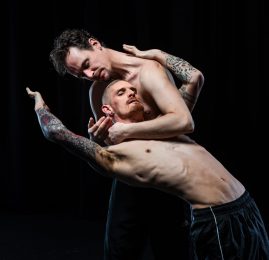An Introduction to Dan Daw

1. What’s the first thing you thought of this morning?
Coffee! I don’t do anything unless I’ve had coffee.
2. What’s the most Australian thing about you?
I tell it like it is, which in the UK, sometimes gets me into trouble. British people are very good at skirting around what they really want to say, which is something the Aussie in me will never fully understand. Having said that, I’ve been here for just over a decade now, so I like to think I’m striking a happy balance.
3. How would you describe your style?
There’s something incredibly empowering about being able to honour, and even celebrate, my working classness by attending board meetings sporting a mohawk, a silver chain and my best Adidas tracksuit. It’s taken me a long time to have the strength of self to dress how I feel most me, and when I’m surrounded by middle class expectation/aspiration to dress and behave a certain way, it takes work to not get swept up in that. This feels really important, particularly now.
4. What’s one thing Candoco fans would be surprised to know about you?
I love watching competition shows. Maybe that’s surprising?
5. What dance work/experience has had the greatest impact on you?
The process of making ‘Thank You Very Much’ with Claire Cunningham and their brilliant creative team. There was something magical about being involved in a work where all the performers identify as disabled. It was a perfect example of how care can and should be embedded into creative processes and is the reason I advocate so strongly for care now in all of the work I do. I remember it being really profound and it was absolutely a defining moment in how I saw myself as a disabled person living in the world.
6. What’s the most memorable dance moment you’ve ever had?
Being offered my first dance contract with FRONTLINEdance back in 2006. It was the year after graduating from drama school and I remember thinking, slightly perplexed: “OK, apparently I’m a dancer now?”.
7. What’s been your biggest learning experience?
Making and touring work has taught me a lot and continues to throw up new things, particularly now. Lessons on kindness and patience feel important.
8. If you weren’t working in the world of dance, what would you be doing?
I’d be a teacher. I idolised my teachers when I was at school, but I instead decided to run away and join the circus.
9. Where is the most surprising place dance has taken you? (literally or emotionally)
Not long after realising I was Queer, I remember going to see ‘Headlock’ by Kate Denborough (KAGE Physical Theatre) at The Malthouse in Melbourne and the final duet between Byron Perry and Luke Smiles just killed me. I remember the piece being quite relentless in its masculine posturing until right at the end, this beautiful, tender, soft duet seemed to emerge from nowhere. I don’t think we have to dig too deep to know what was going on for me there (LOL). I’m even welling up now, thinking about it!
10. How have you described your new role at Candoco to your friends?
“There’s something really, really exciting happening and I’m suddenly quite busy, but I’m not allowed to say why yet”. It’s a relief the cat’s out the bag!
11. What’s been keeping you busy since you re-joined Candoco?
There have been quite a few meetings and a lot of new information to take in. Aside from these, I’ve been using these first few weeks, while we’re still working remotely, to start to get a feel for how each member of the team work best, which is necessary for how I want to be in this role, but it does take the time.
12. Once the current Covid situation is over, what do you think is the biggest challenge Candoco will face?
I think the biggest challenge we face as a company will be audiences feeling it’s safe to return to seeing live work. Building trust with audiences is key to sustaining the work we do, so I think that might take a little while to rebuild.
13. Finally, what can dance be for you?
Looking forward to using these next couple years in post to flesh that out.